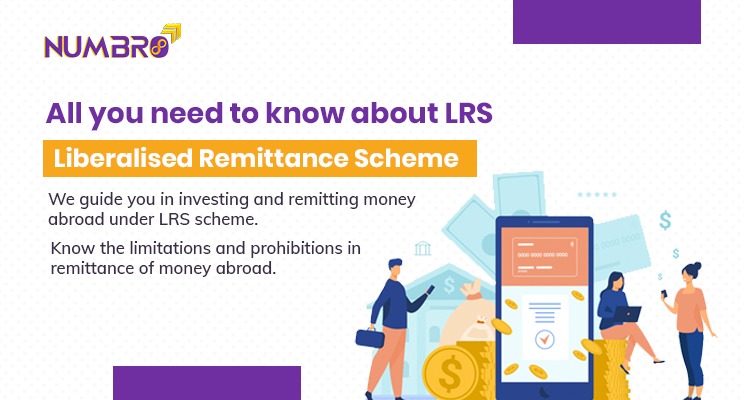LRS is scheme, an individual can use to invest, remit money abroad.
India has made significant progress in liberalizing foreign exchange transactions for its citizens. As many individuals are migrating from India and returning to India, it is important for them to know the remittance limitation, prohibitions to properly adhere to rules of FEMA and Income Tax Act. Following are few things that needs to know for investing in India and transferring money abroad.
Liberalized Remittance scheme (LRS Scheme)
All residents, including minors, are permitted to freely contribute up to USD 2,50,000 per financial year (April-March) for any permitted current or capital account transaction or a combination of both under the Liberalized Remittance Scheme.
The LRS declaration form needs to be countersigned by the minor’s legal guardian if the sender is a minor. Corporations, partnership firms, HUFs, Trusts, etc. are not eligible for the Scheme.
End use of forex under LRS Scheme for individuals
Individuals may use the foreign exchange facility for the following uses, up to a maximum LRS of USD 2,50,000 each fiscal year:
- Individual travel to any nation (except Nepal and Bhutan)
- A donation or gift
- Moving overseas for work.
- Moving away.
- Keeping in touch with family members who live abroad.
- Travel for work, to attend a conference or receive specialized training, to cover medical costs or for an overseas checkup, or to accompany a patient who is receiving treatment or an examination abroad.
- Costs associated with receiving medical care overseas
- Overseas education
- Any other transaction involving a current account that is not covered by the FEMA 1999 definition of a current account.
Limitations under LRS Scheme for individuals
Facilities listed in Schedule III of the FEM (CAT) Amendment Rules, 2015 that are accessible to groups of people other than individuals include:
- Donations of up to 1% of their foreign exchange earnings over the previous three fiscal years, or USD 5,000,000, whichever is less, for (a) the establishment of Chairs in reputable educational institutions, (b) contributions to funds (that are not investment funds) promoted by educational institutions, and (c) contributions to technical institutions, bodies, or associations in the donor company’s industry of operation.
- A commission of up to USD 25,000 or 5% of the inward transfer, whichever is less, is paid to foreign brokers who sell residential apartments or commercial plots in India.
- Remittances of up to USD 10,000,000 per project for all consulting services related to infrastructure projects and USD 1,000,000 per project for all other consulting services obtained from outside India
- Remittances made by an entity in India as compensation for pre-incorporation costs up to 5% of investment brought into India, or USD 100,000, whichever is less.
- Transfers up to USD 250,000 annually for the reasons listed in Schedule III of the FEM (CAT) Amendment Rules, 2015. Nevertheless, all remaining current account transactions carried out by such businesses are otherwise permitted without any set cap and must be settled at the level of Authorized dealer, as in the past. The Authorized Dealer must determine for themselves whether the transaction is real.
- Anything in excess of above limits requires prior approval of RBI
Prohibitions under LRS scheme
Items that are prohibited by the scheme are:
- Remittance for any activity expressly forbidden by Schedule I of the Foreign Exchange Management (Current Account Transactions) Rules of 2000 (such as the purchase of lottery tickets/sweepstakes, prohibited periodicals, etc.) or any item limited by Schedule II.
- Remittance from India to foreign exchanges or a foreign counterparty for margin calls or margin calls.
- Remittances for the purpose of purchasing FCCBs issued by Indian businesses on the international secondary market.
- Remittances for international currency trading.
- Direct or indirect capital account transfers to nations that the Financial Action Task Force (FATF) has from time to time designated as “non-cooperative countries and territories.”
- Remittances sent directly or indirectly to people and organizations that have been warned pose a considerable danger of committing terrorist activities.
Issuing of loans to NRIs/PIO
Subject to the following conditions, a resident individual may make a rupee loan to an NRI/PIO who is a close relative of the resident individual (‘relative’ as defined in Section 2(77) of the Companies Act, 2013) by crossed cheque/ electronic transfer:
- The loan has a one-year minimum maturity period and is interest-free.
- The loan amount must be under the resident person’s overall LRS cap of USD 2,50,000 each fiscal year. It would be the lender’s responsibility to make sure that the loan amount stays under the LRS limit of USD 2,50,000 for the entire fiscal year.
- The borrower must use the loan to cover either personal expenses or his own company needs in India.
- The loan may not be used for any of the following purposes:
- the operation of a chit fund.
- the operation of a Nidhi company.
- the operation of an agricultural or plantation business.
- the purchase or sale of real estate or the construction of farmhouses; or
- the trading in transferable development rights (TDRs).
Criteria
Remittances made through the facility may be combined in respect of immediate family members, provided that each member of the family complies with the terms and conditions of the Scheme. However, if they are not the co-owners or co-partners of the investment, property, or international bank account, other family members are not allowed for clubbing for capital account operations such as opening a bank account, making an investment, or purchasing real estate. Additionally, a resident is not permitted to give another resident a gift in foreign currency for the purpose of crediting the recipient’s foreign currency account maintained overseas under LRS.
The Permanent Account Number (PAN) of the resident person is required for all LRS transactions carried out by Authorized Persons. Any foreign money that is easily convertible may be used for remittances.
Banks, even those without an operational presence in India, must first get permission from the Reserve Bank before they can solicit deposits for their international or overseas branches or represent foreign mutual funds or any other foreign financial services companies.
Maximum amount that can be remitted in an Year
- The frequency of remittances under LRS is unrestricted. However, the cumulative restriction of USD 2,50,000 should be adhered to when buying foreign currency from or sending it through all sources in India during a fiscal year.
- Even if the investment proceeds have been brought back into the country, a resident individual would not be entitled to make any additional remittances under this plan after a remittance for an amount up to USD 2,50,000 is made within the financial year.
- Resident individuals (but not permanently resident in India) who have remitted their entire earnings and salary and wish to further remit ‘other income’ may approach RBI with documents through their Authorized dealer bank for consideration.
- An NRI/PIO who is a close relative of a resident person—defined as a “relative” in Section 2(77) of the Companies Act, 2013—can receive a rupee gift from the resident person by the way of an electronic transfer or crossed check. The gift amount may be recognized as an eligible credit to the NRI or PIO’s Non-Resident (Ordinary) Rupee Account (NRO) and should be credited there. The amount of the gift would fall within the overall cap of USD 250,000 per fiscal year allowed under the LRS for residents. The resident donor would be responsible for making sure that the gift amount being sent is within the LRS and that all of the remittances made by the donor throughout the financial year, including the gift amount, have not exceeded the maximum established under the LRS.
** This is only the brief information about the scheme and its obligations and limitations. There are many things that needs to be addressed before investing and remitting money. If find the above information helpful, do not hesitate to take professional help from us.


